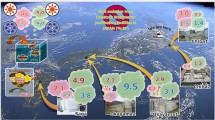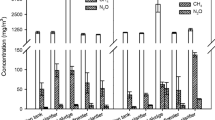Abstract
Methane (CH4) formation in wastewater treatment is linked to long residence times under anaerobic conditions such as those in sewers and primary treatment units. Emissions of this methane to the atmosphere can occur under turbulent flows and, potentially, during aeration in an activated sludge plant. An online, 8-week monitoring campaign of CH4 emissions and operational conditions was conducted to study emissions from a full-scale nitrifying activated sludge plant (ASP). Significant emissions were found throughout the aerated lane, with the highest values observed two thirds down the lane. Emissions had high diurnal and spatial variability, with values ranging from 0.3 to 24 g CH4/h. No significant correlations were found between dissolved oxygen, aeration or influent loads. The results suggest that emissions are linked to upstream process conditions, with potential for methane generation in-lane due periods of limited oxygen availability. The dynamic oxygen profile observed suggests that aerobic and anoxic conditions coexist in the lane, leading to limited oxygen diffusion from the bulk liquid to the inner regions of the floc where anoxic/anaerobic layers may allow methanogenic microorganisms to survive. The average emission factor was 0.07 % of removed chemical oxygen demand, giving a total of 668 kg CH4/year and 14,000 CO2 equivalents/year. The operational carbon associated with the energy requirements of the ASP increased by 5 %. With emerging legislation requiring the reporting of greenhouse gas emissions, the carbon impact may be significant, particularly as the industry moves towards a carbon-reducing future. Therefore, an adequate profiling of full-scale emissions is critical for future proofing existing treatment technologies.





Similar content being viewed by others

References
Aboobakar, A., Cartmell, E., Stephenson, T., Jones, M., Vale, P., & Dotro, G. (2013). Nitrous oxide emissions and dissolved oxygen profiling in a full-scale nitrifying activated sludge treatment plant. Water Research, 47(2), 524–534.
Ahn, K. H., Yoo, H., Lee, J. W., Maeng, S. K., Park, K. Y., & Song, K. G. (2001). Acetate injection into anaerobic settled sludge for biological P-removal in an intermittently aerated reactor. Water Science and Technology, 44(1), 77–85.
Andalib, M., Nakhla, G., McIntee, E., & Zhu, J. (2011). Simultaneous denitrification and methanogenesis (SDM): review of two decades of research. Desalination, 279, 1–14.
Banihani, Q., Sierra-Alavarez, R., & Field, J. A. (2009). Nitrate and nitrite inhibition of methanogenesis during denitrification in granular biofilms and digested domestic sludges. Biodegradation, 20, 801–812.
Cakir, F. Y., & Stenstrom, M. K. (2005). Greenhouse gas production: a comparison between aerobic and anaerobic wastewater treatment technology. Water Research, 39(17), 4197–4203.
Czepiel, P., Crill, P., & Harriss, R. (1993). Methane emissions from municipal wastewater treatment processes. Environmental Science and Technology, 27, 2472–2477.
Daelman, M. R., van Voorthuizen, E. M., van Dongen, L. G., Volcke, E. I., & van Loosdrecht, C. M. (2012). Methane emissions during municipal wastewater treatment plants. Water Research, 46, 3657–3670.
Department for Environment, Food and Rural Affairs (DEFRA) (2009). Guidance on how to measure and report your greenhouse gas emissions. Document PB13309. DEFRA, London, UK. Available at: http://archive.defra.gov.uk/environment/business/reporting/pdf/ghg-guidance.pdf.
El-Fadel, M., & Massoud, M. (2001). Methane emissions from wastewater management. Environmental Pollution, 114, 177–185.
Environment Agency (2009). Carbon water mitigation. Limiting climate change—water industry carbon reduction. Environment Agency, UK. Available at: http://www.environment-agency.gov.uk/static/documents/Research/(16)_Carbon_water_mitigation_FINAL.pdf.
George, K., Thornton, A., & Sadler, R. (2009). Transforming wastewater treatment to reduce carbon emissions - Report: SC070010/R2. Bristol: Environment Agency.
Global Methane Initiative (GMI) (2010). Global methane emissions and mitigation opportunities. Available at: http://www.globalmethane.org/documents/analysis_fs_en.pdf.
Grady, C. Jr., Daigger, G., & Lim, H. (1999). Biological wastewater treatment: principles and practices. New York: M. Dekker, CRC Press.
Gray, N., Miskin, I. P., Kornilova, O., Curtis, T. P., & Head, I. M. (2002). Occurrence and activity of Archaea in aerated activated sludge wastewater treatment plants. Environmental Microbiology, 4(3), 158–168.
Guisasola, A., Sharma, K. R., Keller, J., & Yuan, Z. (2009). Development of a model for assessing methane formation in rising main sewers. Water Research, 43(11), 2874–2884.
IPCC (2006). 2006 IPCC guidelines for national greenhouse gas inventories. Intergovernmental Panel on Climate Change. Available at: http://www.ipccnggip.iges.or.jp/public/2006gl/index.html.
Klüber, H. D., & Conrad, R. (1998). Effects of nitrate, nitrite, NO and N2O on methanogenesis and other redox processes in anoxic rice field soil. FEMS Microbiology Ecology, 25, 301–318.
Lens, P. N., De Poorter, M. P., Cronenberg, C. C., & Verstraete, W. H. (1995). Sulfate reducing and methane producing bacteria in aerobic wastewater treatment systems. Water Research, 29(3), 871–880.
Listowski, A., Ngo, H. H., Guo, W. S., Vigneswaran, S., Shin, H. S., & Moon, H. (2011). Greenhouse gas (GHG) emissions from urban wastewater system: future assessment framework and methodology. Journal of Water Sustainability, 1(1), 113–125.
Roy, R., & Conrad, R. (1999). Effect of methanogenic precursors (acetate, hydrogen, propionate) on the suppression of methane production by nitrate in anoxic rice field soil. FEMS Microbiology Ecology, 28, 49–61.
Søvik, A. K., & Kløve, B. (2007). Emission of N2O and CH4 from a constructed wetland in southeastern Norway. Science of the Total Environment, 380(1–3), 28–37.
Speight, J. (2004). Lange's handbook of chemistry (16th ed.). New York: McGraw-Hill, Inc.
Tallec, G., Garnier, J., Billen, G., & Gousailles, M. (2008). Nitrous oxide emissions from denitrifying activated sludge of urban wastewater treatment plants, under anoxia and low oxygenation. Bioresource Technology, 99, 2200–2209.
Tugtas, A. E., & Pavlostathis, S. G. (2007). Inhibitory effect of nitrogen oxides on a mixed methanogenic culture. Biotechnology and Bioengineering, 96(3), 444–455.
UKWIR. (2008). Carbon accounting in the UK water industry: operational emissions. Report Reference No. 08/CL/01/5. UK Water Industry Research Limited, London.
US Environmental Protection Agency (USEPA) (2006). Global anthropogenic emissions of non-CO2 greenhouse gases: 1990–2020. EPA Report 430-R-06-003. Washington, DC: Office of Atmospheric Programs, Climate Change Division. Report available at: http://www.epa.gov/climatechange/Downloads/EPAactivities/GlobalAnthroEmissionsReport.pdf.
US Environmental Protection Agency (USEPA) (2012). Global anthropogenic emissions of non-CO2 greenhouse gases: 1990–2030. EPA Report 430-R-12-006. Washington, DC: Office of Atmospheric Programs, Climate Change Division. Report available at: http://www.epa.gov/climatechange/Downloads/EPAactivities/EPA_Global_NonCO2_Projections_Dec20-12.pdf.
Wang, J., Zhang, J., Xie, H., Qi, P., Ren, Y., & Hu, Z. (2011). Methane emissions from a full-scale A/A/O wastewater treatment plant. Bioresource Technology, 102, 5479–5485.
Wilhelm, E., Battino, R., & Wilcock, R. (1977). Low pressure solubility of gases in liquid water. Chemical Reviews, 77(2), 219–262.
Yusuf, R. O., Noor, Z. Z., Abba, A. H., Hassan, M. A. A., & Din, M. F. M. (2012). Methane emission by sector: a comprehensive review of emission sources and mitigation methods. Renewable and Sustainable Energy Reviews, 16, 5059–5070.
Zeng, R. J., Lemaire, R., Yuan, Z., & Keller, J. (2003). Simultaneous nitrification, denitrification, and phosphorus removal in a lab-scale sequencing batch reactor. Biotechnology and Bioengineering, 84, 170–178.
Zhen, H., Zhang, J., Xie, H., Li, S., Zhang, T., & Wang, J. (2011). Identifying sources of nitrous oxide emission in anoxic/aerobic sequencing batch reactors (A/O SBRs) acclimated in different aeration rates. Enzyme and Microbial Technology, 49, 237–245.
Acknowledgments
The authors gratefully thank Severn Trent Water for funding this research through a PhD sponsorship and for the helpful support of the operations team at the Sewage Treatment Works in facilitating the field work.
Author information
Authors and Affiliations
Corresponding author
Rights and permissions
About this article
Cite this article
Aboobakar, A., Jones, M., Vale, P. et al. Methane Emissions from Aerated Zones in a Full-Scale Nitrifying Activated Sludge Treatment Plant. Water Air Soil Pollut 225, 1814 (2014). https://doi.org/10.1007/s11270-013-1814-8
Received:
Accepted:
Published:
DOI: https://doi.org/10.1007/s11270-013-1814-8



